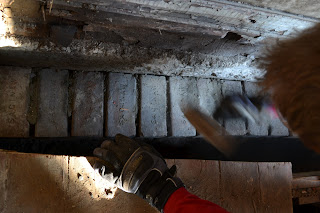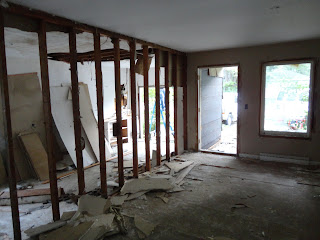One of the hardest challenges of this project is to negotiate the proportions of time spent social networking vs material salvaging vs actually turning those materials into something useful at Spencer's. Add in the unpredictable nature that applies to all three, and we have a tough time answering someone when they ask what our "typical day" is like.
Wednesday morning we found a Craigslist post: free construction lumber.
"Probably from a small house renovation, shed, deck, or the like," we thought. The next thing we know, we're in the car, giddy, and on our way to a decrepit bowling alley.
While builders in Detroit were short on brick and other materials, Bob - the man in charge of deconstructing the bowling alley - was buying houses for $1 and deconstructing them for their valuable and well-crafted innards, and feeding them right back into other jobs.
Bob greets us at the site, where he and his two-man crew have already done substantial work. The valuable materials within are what they're paid with: concrete blocks, steel trusses, thick maple alleyways, the anonymous workings of bowling ball return.
Among these are a few things they can't sell: loads of 2x10's, pieces of rubber roofing, and even a few large chunks of maple bowling lane. We start with the raised dance floor in the rear of the building. Oak flooring covers the 3/4" tongue-and-groove OSB and 2x10's that structures it - perfect materials to reinforce our floors and resheath our roof.
There is more lumber than we can probably use, so efforts are shifted to the roof.
The roof and parapets are covered with a thick rubber membrane. The flat surface is in poorer condition - shrunken and cracked from years of exposure to the sun. But the vertical pieces covering the parapet have weathered well. From the large squares we cut out of this we can build a layered waterproof surface for the flat roof at Spencer's.
Bob graciously offers to crane our new roof to the ground
On our way out, the crew stumbles upon a massive bee hive in a boarded up window cavity. Bob Sr. hopes to transplant them and harvest the honey.
And we taste test.
Trip 1. Though we're only able to fit a fraction of the gathered materials in, the truck is full. We head back later this week.

























.JPG)
.JPG)































